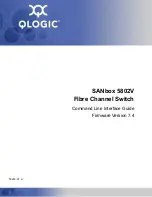
Quality of Service
Configuring QoS Advanced Mode
Cisco 220 Series Smart Switches Administration Guide Release 1.1.0.x
266
18
-
DSCP
—All IP traffic is mapped to queues based on the DSCP field in the
IP header. The actual mapping of the DSCP to queue can be configured
on the DSCP to Queue page. If traffic is not IP traffic, it is mapped to the
best effort queue.
-
IP Precedence
—Traffic is mapped to queues based on the IP
precedence. the actual mapping of the IP precedence to queue can be
configured on the IP Precedence to Queue page.
-
CoS/802.1p-DSCP
—Select to use Trust CoS mode for non-IP traffic and
Trust DSCP mode for IP traffic.
•
Default Mode Status
—Select the default trust mode (either trusted or
untrusted) for interfaces. This provides basic QoS functionality in QoS
advanced mode, so that you can trust CoS/DSCP on advanced QoS by
default (without having to create a policy).
In QoS advanced mode, when the Default Mode Status is set to Not Trusted,
the default CoS values configured on the interface will be used for
prioritizing the traffic arriving on the interface.
If you have a policy on an interface then the default mode is irrelevant, the
action is according to the policy configuration and unmatched traffic is
dropped.
STEP 3
Click
Apply
. The Running Configuration is updated.
Configuring Class Mapping
A class map defines a traffic flow with ACLs. MAC-based ACL, IPv4-based ACL,
and IPv6-based ACL can be combined into a class map. Class maps are
configured to match packet criteria on a match-all or match-any basis. They are
matched to packets on a first-fit basis, meaning that the action associated with the
first-matched class map is the action performed by the switch. Packets that match
the same class map are considered to belong to the same flow.
NOTE
Defining class maps does not have any effect on QoS. It is an interim step, enabling
the class maps to be used later.
If more complex sets of rules are needed, several class maps can be grouped into
a super-group called a policy (see the
section).
















































